Standards Council Of Canada
-
- Winch Safety through Standardization Marine News, Jul 2014 #47
Celebrating the 10,000th YoYo Winch
For decades, barge owners and operators had no reason to think twice about their rigging. There were only a few choices when it came to winches, and there were ratchets as well. Because of the simplicity of these machines, few people in the industry were compelled to think critically about how such a basic item might be improved. But winches and ratchets have their downsides: fouling and birdnesting can and do happen. Wire rope is heavy, and traditional rigging takes a lot of it. And old-fashioned winches require a good amount of time and effort to operate. But what else was there?
In 2008, the Patterson Manufacturing Company, of Pittsburgh, Pa., developed the YoYo Barge Winch, a revolutionary design that reflected a total rethinking of the way winches do their job. And now, within the next few months, Patterson is on track to deliver its 10,000th winch—a significant milestone that reflects just how thoroughly the YoYo has taken over North America’s waterways in just a few years.
Keeping an Ear on the Customer
David Grapes, president and CEO of Patterson, is not surprised at the YoYo’s success. That’s because the YoYo is a direct result of customer feedback, something the people at Patterson respect and value. The engineers had originally come up with an idea for a YoYo-style power winch, and they presented this to the people at American Electric Power (AEP), headquartered in St. Louis, Mo. and Patterson’s biggest customer. AEP was interested, but it turned out that what they really wanted was a manual winch for barges. “We expanded the idea from there,” says Grapes, “and everybody in the industry has embraced it.”
That’s not an exaggeration—Patterson figures that, counting rebuilds and re-rigging, the YoYo has been the preferred winch for several years for more than 50% of the winches in play on an annual basis. With approximately 4,000 to 5,000 winch-sale opportunities per year, that’s a lot of YoYos. And once the 10,000th YoYo winch is installed, an overwhelming majority of barges built in the last five years in the U.S. will boast this revolutionary design.
What does this mean for the inland waterways shipping industry? It means heightened productivity and profitability. Because the YoYo uses a single-stacking design, operators no longer have to deal with springcoil, fouling, and uncontrolled spooling. A patented double-dog design allows easy maximum line tensioning and makes it simple to use. The 25 feet of takeup (or 40 feet for tank barge applications) mean less wire rope to heave around and eventually untangle. “The deckhands all prefer the YoYo,” says Grapes.Making a Tough job a Little Easier
People at AEP confirmed this preference. “Throughout my 35 years of decking, I’ve had to use hundreds of different types of winches. The YoYo winch is nothing like conventional winches,” says Syd Gibbeaut, port mate (now retired) at AEP River Operations. “This is certainly an amazing winch, one that will have a major impact on our industry.”
Bruce Darst, also retired from his position as port captain at AEP, concurs. During the testing, he said, “We’ve been using the Patterson YoYo winch as a barge connector for three years. The winch has proven to be super-dependable and is both easy to tighten and to pull wire off the drum. It’s also very easy to replace the wire. We’ve been field-testing eight of these winches and have only replaced one wire in that time, which also suggests it extends the working life of the wire cable. Because of its innovative design, it’s impossible for the wire to become entangled or birdnested on the drum. This is the winch’s biggest advantage and saves untold time and effort in building tow. It’s a very high quality winch, easy to use and maintain, and is far superior to the barge-connecting winches that have been commonly used in the past.”
John Byer, AEP boat captain, sums up one of the main reasons the YoYo is so popular: “Once you start to pull the wire off of the winch, as a result of the winch design, the wire pays itself off the winch. It’s the best mousetrap out there, and it’s where we need to be.”
A Partnership in Testing Innovation
AEP’s involvement in the development of the YoYo was instrumental. Patterson provided with company with some of the first products, and they tested them over two years. AEP personnel collected both quantitative and qualitative information on ease of use, time savings, injury reduction rates, ROI, and overall savings. By the end of the trial period, AEP had concluded that they could save millions of dollars by making the YoYo their standard winch.
As a result of those years of development and testing with AEP, Patterson has determined that the YoYo is 50% faster than ratchets, which, according to the company’s innovative ROI calculator, means that the winch actually pays for itself in a short amount of time. Safety is also a plus—less birdnesting means fewer man-overboard opportunities.
Standardization Brings Safety and Efficiency
Taylor Grapes, engineering director at Patterson, notes that the increasing prevalence of the YoYo is leading naturally to a positive change throughout the entire inland shipping industry, not just at AEP: standardization. With all of Patterson’s customers using the YoYo (including the three biggest towing operations in the industry) and increasing numbers of barges adding the YoYo on a continuing basis, he envisions a day when every barge will be exclusively equipped with this new design.
“The YoYo is becoming the de facto standard in this industry,” he says. “As more and more owners and operators upgrade, rebuild, re-rig, or build from scratch, the more YoYos we’ll see, until basically you’ll have nothing but the YoYo on board anywhere.” This represents a positive outcome for Patterson, of course: if owners are specifying the YoYo; that means more sales for the company.
Standardization also benefits the industry as a whole. Most industries agree that voluntary technical and trade agreements among experts contribute to increased safety, predictable outcomes, and better business—this is why organizations like the International Standards Organization, or ISO, exist. Engineers and economists at many standards groups including the ISO, the World Trade Organization (WTO), and the Standards Council of Canada have conducted a multitude of global studies proving the measurable value of standards as they apply to a variety of industries.
Beyond formal standards, the adoption of a standardized technology increases user familiarity, which results in safer conditions. If every deckhand is familiar with the operation of the YoYo, and the YoYo is on every barge, then that means everyone can work swiftly and safely anywhere without the downtime associated with overcoming the learning curve.
Another advantage to standardizing the YoYo is increased productivity. Because this winch allows workers to make and break a tow in half the time it takes to do it with ratchets, operators can ensure that more of their time is spent actually out on the river. The elimination of fouling also saves time and effort while increasing user safety. These enhanced efficiencies can really add up when extrapolated to consider the average number of barges per tow.
Beyond North America
Taylor Grapes is pleased with the overwhelming success of the YoYo winch in North America, but he is setting his sights higher for the business in the future. “As the South American market continues to modernize and mature, we envision an influx of YoYos onto both Hidrovia and Amazon barges,” he says. “The Hidrovia Waterway is the Mississippi of South America, and everybody is rethinking up their operations right now as these markets grow and mature. It simply stands to reason that our winch could lead to the same sorts of operator savings and success in these markets as we’ve had here in the U.S.”
Patterson has already begun branching out into South America over the past six years—and business is booming. “Combined revenues from the three primary markets in South America (the Parana-Paraguay Hidrovia, the Amazon, and the Magdalena) have increased every year since we first entered these markets, and we expect this to continue,” adds Grapes.
Eventually, Patterson will move into the shipping market of the lower Danube River, which is in the process of modernizing and expanding its market for United States shippers. Because of low river levels (and historic but low bridges), self-propelled barges are the norm on the Danube. Patterson believes there is a market there for advanced technology like the YoYo.
(As published in the July 2014 edition of Marine News - http://magazines.marinelink.com/Magazines/MaritimeNews)
-
 )
March 2024 - Marine Technology Reporter page: 42
)
March 2024 - Marine Technology Reporter page: 42NEW TECH OCEANOLOGY INTERNATIONAL 2024 Image courtesy Greg Trauthwein Image courtesy BIRNS MacArtney launches the new ultra-compact ø12.7 mm SubConn Nano connector. Innovative connectivity built on 45 years of ? eld-proven and market-trusted design. Image courtesy MacArtney Birns celebrated its 70th
-
 )
March 2024 - Marine Technology Reporter page: 35
)
March 2024 - Marine Technology Reporter page: 35Figure 1 A self-righting vehicle design with buoyancy high and weight low, WHOI’s SeaBED AUV captures the attention of a pair of curious Antarctic penguins as it is deployed from the British research vessel James Clark Ross. Vehicle designers allowed for temperature reduction of battery capacity. Recharge
-
 )
March 2024 - Marine Technology Reporter page: 29
)
March 2024 - Marine Technology Reporter page: 29n January, Norway said “yes” to sea- bed mining, adding its weight to the momentum that is likely to override the calls for a moratorium by over 20 countries and companies such as I Google, BMW, Volvo and Samsung. Those against mining aim to protect the unique and largely unknown ecology of the sea?
-
 )
March 2024 - Marine Technology Reporter page: 23
)
March 2024 - Marine Technology Reporter page: 23elatively inactive since 2014, the Hunga Tonga–Hunga Ha‘apai (HT-HH) submarine volcano began erupting on December 20, 2021, reaching peak intensity on January 15, 2022. This triggered tsunamis throughout the Pa- R ci? c, destroyed lives and infrastructure, and generated the largest explosion recorded
-
 )
March 2024 - Marine Technology Reporter page: 17
)
March 2024 - Marine Technology Reporter page: 17• Integrity assessment, and otherwise covered, e.g., by rock dump. As for depletion of • Mitigation, intervention and repair. sacri? cial anodes, this can be dif? cult or even impossible to Selecting the best method for collecting the data these work- estimate due to poor visibility, the presence of
-
 )
March 2024 - Marine Technology Reporter page: 15
)
March 2024 - Marine Technology Reporter page: 15sensor options for longer mission periods. About the Author For glider users working in ? sheries and conservation, Shea Quinn is the Product Line Manager the Sentinel can run several high-energy passive and active of the Slocum Glider at Teledyne Webb acoustic sensors, on-board processing, and imaging
-
 )
March 2024 - Marine Technology Reporter page: 14
)
March 2024 - Marine Technology Reporter page: 14TECH FEATURE TELEDYNE SLOCUM GLIDERS to hold over 3.5 times as many lithium primary batteries as the the water column and its thrusters give it the ability to stay standard Slocum Glider, and to physically accommodate up to on track in strong currents or other dif? cult ocean condi- 8 different sensor
-
 )
March 2024 - Marine Technology Reporter page: 13
)
March 2024 - Marine Technology Reporter page: 13nyone familiar with glider hardware options integrated for a broad Glider answers that need,” said Shea autonomous underwater ve- range of missions. Quinn, Slocum Glider Product Line hicles (AUVs) is certainly “As the use of Slocum Gliders grew, Manager at TWR. A familiar with the popular- so did
-
 )
April 2024 - Maritime Reporter and Engineering News page: 43
)
April 2024 - Maritime Reporter and Engineering News page: 43crucial,” – Eero Lehtovaara, Head of Regulatory & Public Affairs, ABB Marine & Ports All images courtesy ABB Marine and Ports providers on developing standards and print and accelerate the commercialized tection. The work would also demand a regulations to help digitalization nurture scaling-up of solutions
-
 )
April 2024 - Maritime Reporter and Engineering News page: 14
)
April 2024 - Maritime Reporter and Engineering News page: 14Book Review Approach to Meeting Underwater Radiated Noise Limits Def ned By Raymond Fischer uantitative underwater radiated noise limits will construction inspections, 5) possible training with respect to be developed shortly by IMO, and/or countries salient design/construction essentials, 6) compliance
-
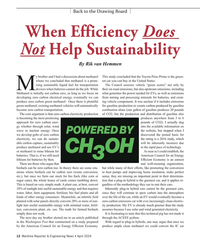 )
April 2024 - Maritime Reporter and Engineering News page: 12
)
April 2024 - Maritime Reporter and Engineering News page: 12Back to the Drawing Board When Efficiency Does Not Help Sustainability By Rik van Hemmen y brother and I had a discussion about methanol This study concluded that the Toyota Prius Prime is the green- where we concluded that methanol is a prom- est car you can buy in the United States. ising sustainable
-
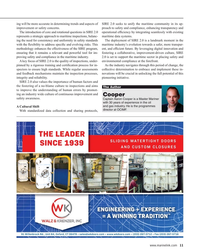 )
April 2024 - Maritime Reporter and Engineering News page: 11
)
April 2024 - Maritime Reporter and Engineering News page: 11existing represents a strategic approach to maritime inspections, balanc- maritime data systems. ing the need for consistency and uniformity in safety standards The deployment of SIRE 2.0 is a landmark moment in the with the ? exibility to address speci? c and evolving risks. This maritime industry’s
-
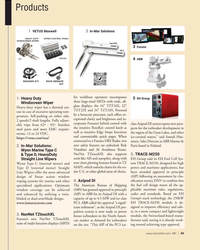 )
April 2024 - Marine News page: 43
)
April 2024 - Marine News page: 43can be achieved (ABS) has granted approval in principle plicable maritime rules, regulations, (AIP) to ABB for its Azipod DI with a codes and standards. Based on EH and enhanced by utilizing a twin- capacity of up to 4.5 MW and ice class Group’s stack technology, the 250kW bladed or dual-arm/blade
-
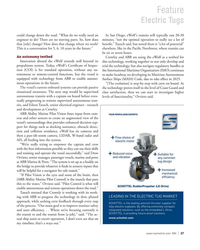 )
April 2024 - Marine News page: 37
)
April 2024 - Marine News page: 37Feature Electric Tugs could change down the road. “What do we really need an In San Diego, eWolf’s transits will typically run 20-30 engineer to do? There are no moving parts. So, how does minutes, “not the optimal operation to really see a lot of that [role] change? How does that change where we work?
-
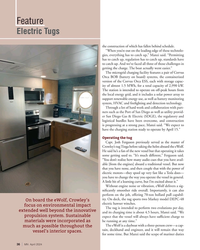 )
April 2024 - Marine News page: 36
)
April 2024 - Marine News page: 36out on the leading edge of these technolo- gies, everything has to catch up,” Manzi said. “Permitting has to catch up, regulation has to catch up, standards have to catch up. And we’ve faced all three of those challenges in getting the charge. The boat actually went easier.” The microgrid charging facility
-
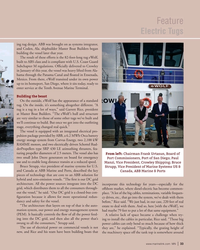 )
April 2024 - Marine News page: 33
)
April 2024 - Marine News page: 33Feature Electric Tugs ing tug design. ABB was brought on as systems integrator, and Coden, Ala. shipbuilder Master Boat Builders began building the vessel later that year. The result of these efforts is the 82-foot-long tug eWolf, built to ABS class and is compliant with U.S. Coast Guard Subchapter M
-
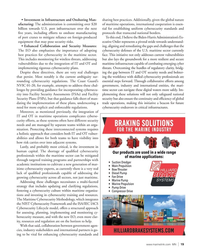 )
April 2024 - Marine News page: 19
)
April 2024 - Marine News page: 19operations, international cooperation is essen- billion towards U.S. port infrastructure over the next tial for establishing uniform cybersecurity standards and ? ve years, including efforts to onshore manufacturing protocols that transcend national borders. of port cranes to mitigate reliance on foreign-pr
-
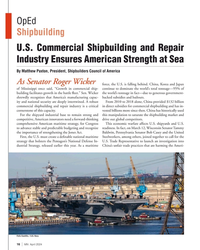 )
April 2024 - Marine News page: 16
)
April 2024 - Marine News page: 16OpEd Shipbuilding U.S. Commercial Shipbuilding and Repair Industry Ensures American Strength at Sea By Matthew Paxton, President, Shipbuilders Council of America As Senator Roger Wicker force, the U.S. is falling behind. China, Korea and Japan of Mississippi once said, “Growth in commercial ship-
-
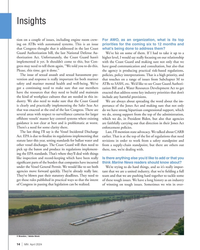 )
April 2024 - Marine News page: 14
)
April 2024 - Marine News page: 14is due to ? nalize its regulations implementing that earlier. That is at the top of the list of regulations that need statute later this year, setting standards for ballast water and revisions in order to work from a safety standpoint and other vessel discharges. The Coast Guard will then need to from
-
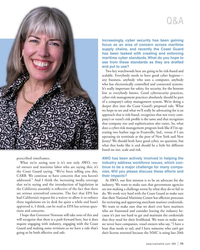 )
April 2024 - Marine News page: 11
)
April 2024 - Marine News page: 11focus as an area of concern across maritime supply chains, and recently the Coast Guard has been tasked with creating and enforcing maritime cyber standards. What do you hope to see from these standards as they are drafted and put to use? Two key watchwords here are going to be risk-based and scalable
-
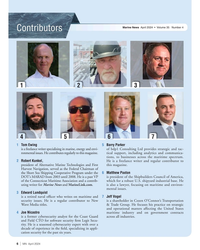 )
April 2024 - Marine News page: 6
)
April 2024 - Marine News page: 6Marine News April 2024 • Volume 35 Number 4 Contributors 1 2 3 5 4 6 7 1 Tom Ewing 5 Barry Parker is a freelance writer specializing in marine, energy and envi- of bdp1 Consulting Ltd provides strategic and tac- ronmental issues. He contributes regularly to this magazine. tical support, including
-
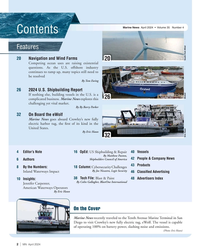 )
April 2024 - Marine News page: 2
)
April 2024 - Marine News page: 2Marine News April 2024 • Volume 35 Number 4 Contents Features 20 Navigation and Wind Farms 20 Competing ocean uses are raising existential questions. As the U.S. offshore industry continues to ramp up, many topics still need to be resolved By Tom Ewing 26 2024 U.S. Shipbuilding Report If
-
 )
February 2024 - Maritime Reporter and Engineering News page: 44
)
February 2024 - Maritime Reporter and Engineering News page: 44Ma- of multiple units and ? exibility in ad- demands of the shipping industry for rineShaft stock raw materials for almost black carbon emission standards. The any emergency, whether a replacement EMS method enables real-time in-situ for tail shaft, intermediate shaft, rudder measurement capabilities
-
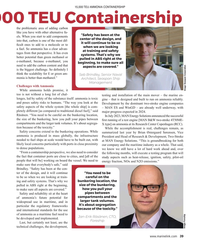 )
February 2024 - Maritime Reporter and Engineering News page: 39
)
February 2024 - Maritime Reporter and Engineering News page: 39volumes. widespread use in maritime, and in It’s about segregation particular the regulatory frameworks because of the toxicity.” and international standards for the use of ammonia as a maritime fuel need to Jan-Erik Räsänen, CTO, be developed and implemented. Foreship Last, but certainly not least
